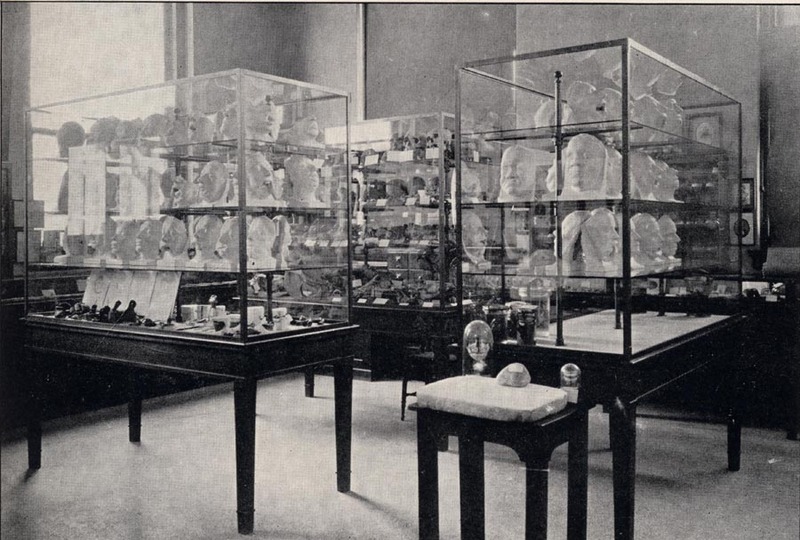Decay
By 1935, some cooling in relations between Dean Miner and Adelbert Fernald is evident in their existing correspondence. As preparations began for Harvard University's tercentenary, the Dean wrote, "Among other things which I would like to have especially striking is our museum. I have had considerable criticism from time to time from people who know museums, that at present ours is not particularly orderly and much of our material is ineffectively displayed." Miner commissioned a report on the Dental Museum from Arthur Loveridge, a curator at Harvard's Museum of Comparative Zoology. Loveridge recommended an overhaul of the Museum, better labeling "in place of the handwritten and frequently illegible ones now exhibited," and a more orderly selection of objects for display. He was hired for three months to complete this renovation, and as the Dean stated in his annual report, "Our Museum has been completely reorganized …. in its most effective form with proper cataloguing ….We feel now that our Museum is in such a condition as to be an effective part of our teaching program." As one of the consequences of the Loveridge renovations, a number of specimens were transferred from the Dental Museum to the Museum of Comparative Zoology and also the Peabody Museum.
At this time also, the policies of the University towards retirees changed, and in June, 1936, at the age of 64, Adelbert Fernald retired as curator, stating:
”Your record of my age is correct. During the last twenty-five years I hope I have been of some service to the school… For eight years, before becoming officially connected with the school, it gave me great pleasure to assist the late Dr. W. E. Boardman in assembling many books and magazines for the library, together with hundreds of specimens for the museum. I, personally, collected over eleven-hundred dollars ($1,100.) to pay for having the largest showcases constructed…. I regret that I have not done more. Please rest assured I shall always have the interest of the school at heart and I sincerely hope that I may yet be able to do something worth while."
Fernald went on, in fact, to create a loan fund for dental students in his mother's memory and then accepted an appointment as special orthodontist at Phillips Exeter Academy, continuing in practice until his death in 1958.
Details of the last years of the Dental Museum are surprisingly difficult to trace, and its end is nearly as obscure as its origin. The 1937 catalog of the Dental School is the last to contain any entry describing its holdings:
The Dental Museum has been organized to illustrate the growth of dentistry as an art and a science. The evolution of dental practice is portrayed by collections of instruments, appliances, and pathologic specimens, dating from early days up to the present time. Specimens of human and comparative anatomy, normal and pathologic, have been assembled for teaching purposes and study. Models for comparative studies of the mouth of civilized and primitive peoples are among the Museum's valuable specimens. There are sets of plaster reproductions of the teeth of the vegetable eaters of Yucatan, showing deplorable and insanitary conditions; and also of the meat-eaters on the extreme northern coast of Labrador, Baffin Land, and Etah, showing almost perfect dental and oral health. Of especial interest is the Kazanjian Collection of facial casts and appliances, showing the reconstructive surgery and prosthesis performed on wounded soldiers by V. H. Kazanjian, D.M.D. '05, during the World War.
By November 1936, Dean Miner, due to "the change in policy in the management of the museum,"delayed appointment of a new curator, and a number of plans were debated. There was some discussion of appointing Adelbert Fernald as curator emeritus, at least on an unofficial basis, and possibly hiring Arthur Loveridge as curator or advisor, but it was ultimately resolved to allow the Standing Committee on the Museum to oversee the operations with counsel from outside the school. It was not until April 1937, that Dr. Kurt H. Thoma, the Brackett Professor of Oral Pathology at the Dental School, was given the appointment of curator, at least for an interim period, working closely with the members of the Standing Committee.
According to the 1937/38 report of the Dental School to the University, “The expansion of the Department of Oral Medicine which was started last year has been so rapid that we were obliged to take over the space occupied by the Museum.” A few additional acquisitions to the collections are noted in the minutes and correspondence of the Administrative Board through the end of 1939, but there is no indication where the Museum actually was at this time, or whether it was even accessible. The records of the Dental School contain an outline of the contents of the antique dental office made in July 1938—possibly with a view to packing or storing the items in preparation for a move—but no other mention is made of the fate of the Museum itself. The annual catalogs of the Dental School do not list a curator of the Museum after 1937, and the 1940 edition of the catalog is the last to list even a Standing Committee on the Museum.

